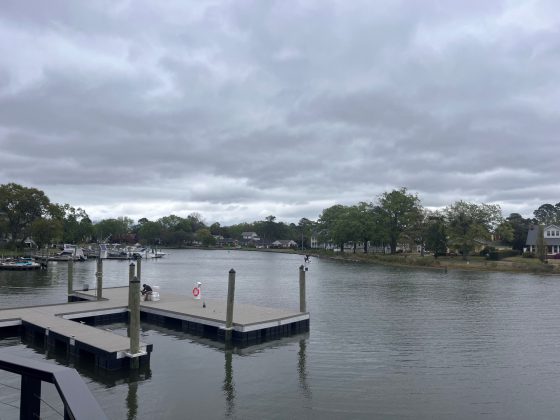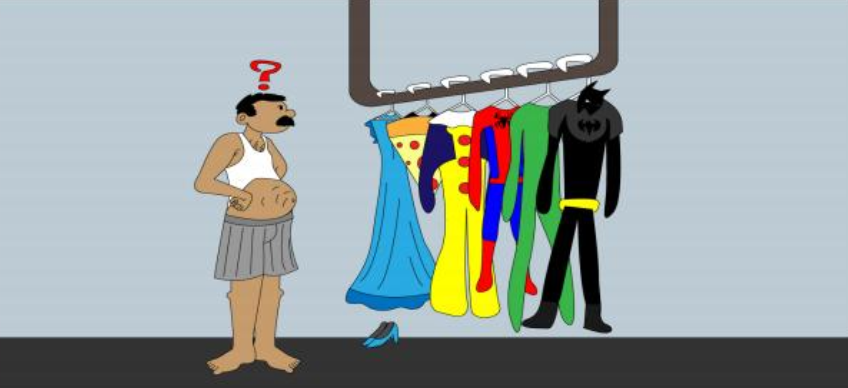The Ryan Resilience Lab boasts a dock on Knitting Mill Creek under a gray sky.
Amalia Houff|Marlin Chronicle
It may have been a cold and gray Saturday along Knitting Mill Creek, but the energy radiating from the Earth Day EcoDistrict Extravaganza warmed the hearts of every visitor who passed through the vibrant Ryan Resilience Lab. Hosted by the Elizabeth River Project (ERP), the free event brought together local families, community partners, environmental advocates and curious newcomers to celebrate Earth Day through crafts, education and grassroots environmental action. Despite the overcast sky, the whimsy of pelican hats, vibrant coloring sheets and the hum of excited conversations lit up the Resilience Lab like spring sunlight.
Nestled between Park Place and Highland Park in Norfolk, the EcoDistrict is a unique, community-driven initiative focused on the health of the environment.
“This is the day that we created to highlight all of the environmental actions that are taking place along the north corridor,” Jamie Melvin, Engagement and EcoDistrict manager with the Elizabeth River Project, said. Attendees could take guided tours of the stunning Ryan Resilience Lab, a building designed to model sustainable adaptation for sea level rise and climate change. The indoor River Room showcased “Edge Effect Art Exhibition,” a striking space for environmental art featuring photographs by Jerome Ellis. Attendees were encouraged to create their own Edge Effect hourglasses, commenting on what they think is necessary to survive this climate moment.
At education tables sprawled throughout the lab, kids and adults alike joined in coloring in native Chesapeake Bay species and learning about environmental initiatives like bird-safe window film and dark sky lighting. Pam Northam, former First Lady of Virginia and an enthusiastic advocate for environmental education, spent the afternoon engaging with the youngest guests, answering their questions and cheering on their creativity. But the crafts weren’t just for kids — young adults, seniors and everyone in between took home handmade keepsakes and newfound knowledge.
“We want to energize the community to participate in environmental action, but in a way that’s approachable,” Melvin said. “There’s going to be a big emphasis inside on talking about the efforts you are already doing… like turning off your lights when you leave the house. That’s directly benefiting the environment.”
Outside, there were real examples of oyster castles and native shoreline gardens — key tools in the effort to restore the Elizabeth River ecosystem.
“It’s super cool to come through this and listen to them talk about how [the building] was built for rising sea level and how we practice what we preach,” Mandi Pesha, a 2024 graduate of Virginia Wesleyan University and the ERP’s River Star Communications specialist, said. “You come out here, you learn about rain gardens, you learn about shorelines, oyster recruitment—everything that has helped this river become so healthy.”
Pesha first encountered the Elizabeth River Project through a class at Virginia Wesleyan University, and she’s been hooked ever since. “After volunteering on a shoreline, I was like, oh my gosh, that was so cool,” she said. “I want to be a part of this.”
At the event, Pesha helped educate homeowners about the River Star Homes program, a free initiative where homeowners pledge to follow seven simple steps to keep the river clean. The program even offers cost-share opportunities for conservation landscaping, rain gardens and native plant installations. “We try to help, even if someone can’t afford the cost-share,” she said. “We still give them resources.” From oyster gardening demos in partnership with the Chesapeake Bay Foundation to sign-ups for Otter Spotter and Chesapeake Water Watch, the event offered a little something for everyone. “This event is so great because it’s partnering with the EcoDistrict,” Pesha said. “It’s all about people coming from the same community to preach about the same messages.”
Beyond the education and festivities, the Ryan Resilience Lab itself stood as a testament to the EcoDistrict’s core values—resilience, innovation and community empowerment. Designed with living shorelines, permeable pavement, rain gardens, barrels and a green roof, the Lab doesn’t just teach sustainability, it embodies it. The EcoDistrict continues to evolve with input from residents, aiming to create a more environmentally responsible neighborhood. Local businesses like the Starving Artist Cafe, Lady Ferns Native Plants, Aardvark Glass Gallery and Colley Ave Tattoo highlight the EcoDistrict’s presence in not only food/drink, but also retail, arts and other options for the community, proving that environmental engagement and economic vitality can go hand in hand.
Perhaps the most inspiring message of the event was the reminder that science and sustainability aren’t confined to labs or lecture halls — they live in our businesses, our neighborhoods, our shorelines and the playful joy of a child (or even an adult!) in a pelican hat. “There are people who want to spend their Saturday giving the earth some love,” Melvin said, and at the EcoDistrict Extravaganza, that’s exactly what they did
By Amalia Houff
aehouff@vwu.edu

